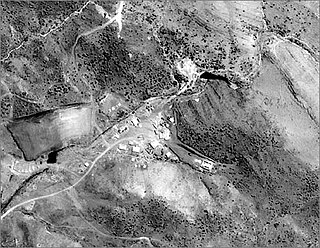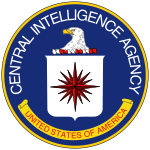
Khalid Muhammad Abdallah al-Mihdhar was a Saudi Arabian hijacker. He was one of the five hijackers of American Airlines Flight 77, which was flown into the Pentagon as part of the September 11 attacks.
The hijackers in the September 11 attacks were 19 men affiliated with al-Qaeda. They hailed from four countries; fifteen of them were citizens of Saudi Arabia, two were from the United Arab Emirates, one was from Lebanon, and the last was from Egypt. The hijackers were organized into four teams, each led by a pilot-trained hijacker who would commandeer the flight with three or four "muscle hijackers" who were trained to help subdue the pilots, passengers, and crew. Each team was assigned to a different flight and given a unique target to crash their respective planes into.

George John Tenet is a former Director of Central Intelligence (DCI) for the United States Central Intelligence Agency as well as a Distinguished Professor in the Practice of Diplomacy at Georgetown University.

Operation Infinite Reach was the codename for American cruise missile strikes on Al-Qaeda bases in Khost, Afghanistan, and the Al-Shifa pharmaceutical factory in Khartoum, Sudan, on August 20, 1998. The attacks, launched by the U.S. Navy, were ordered by President Bill Clinton in retaliation for al-Qaeda's August 7 bombings of American embassies in Kenya and Tanzania, which killed 224 people and injured over 4,000 others. Operation Infinite Reach was the first time the United States acknowledged a preemptive strike against a violent non-state actor.

Joseph Cofer Black is a former CIA official who was appointed Ambassador-at-Large and Coordinator for Counterterrorism by President George W. Bush and led the Office of Counterterrorism in the U.S. State Department until his resignation in 2004. Previously Black served in the Directorate of Operations at the Central Intelligence Agency (CIA) and Director of the CIA's Counterterrorism Center (CTC).
On September 11, 2001, 19 Muslim hijackers took control of four commercial aircraft and used them as suicide weapons in a series of four coordinated acts of terrorism to strike the World Trade Center in New York City, The Pentagon in Arlington County, Virginia, and an additional target in Washington, D.C. Two aircraft hit the World Trade Center while the third hit the Pentagon. A fourth plane never arrived at its target, crashing in a field in Pennsylvania after a passenger revolt. The intended target is believed to have been either the United States Capitol or the White House. As a result, 2,977 victims were killed, making it the deadliest foreign attack on U.S. soil, exceeding Japan's surprise attack on Pearl Harbor in Honolulu, Hawaii, on December 7, 1941, which killed 2,335 members of the United States Armed Forces and 68 civilians. It was carefully planned by al-Qaeda, who sent 19 terrorists to take over Boeing 757 and Boeing 767 aircraft, operated by American Airlines and United Airlines.
Gary Berntsen is a former Central Intelligence Agency (CIA) career officer who served in the Directorate of Operations between October 1982 and June 2005. During his time at the CIA, he served as a CIA Station Chief on three separate occasions and led several of CIA’s most important counterterrorism deployments including the United States’ response to the East Africa Embassy bombings and the 9/11 attacks. He was awarded the Distinguished Intelligence Medal in 2000 and the Intelligence Star in 2004.
Gary C. Schroen is a former Central Intelligence Agency field officer who was in charge of the initial CIA incursion into Afghanistan in September 2001 to topple the Taliban regime and to destroy Al-Qaeda.

The September 11 attacks, often referred to as 9/11, were a series of four coordinated terrorist attacks by the Wahhabi terrorist group Al-Qaeda against the United States on the morning of Tuesday, September 11, 2001. The attacks resulted in 2,977 fatalities, over 25,000 injuries, and substantial long-term health consequences, in addition to at least $10 billion in infrastructure and property damage. It is the single deadliest terrorist attack in human history and the single deadliest incident for firefighters and law enforcement officers in the history of the United States, with 343 and 72 killed, respectively.

The Central Intelligence Agency is a civilian foreign intelligence service of the federal government of the United States, officially tasked with gathering, processing, and analyzing national security information from around the world, primarily through the use of human intelligence (HUMINT). As a principal member of the United States Intelligence Community (IC), the CIA reports to the Director of National Intelligence and is primarily focused on providing intelligence for the President and Cabinet of the United States.
The Bin Laden Issue Station (1996–2005) was a unit of the Central Intelligence Agency dedicated to tracking Osama bin Laden and his associates.
Hassan Ghul, born Mustafa Hajji Muhammad Khan, was a Pakistani member of al-Qaeda who revealed the kunya of Osama Bin Laden's messenger, which eventually led to Operation Neptune Spear and the death of Osama Bin Laden.
Some sources have alleged that the Central Intelligence Agency (CIA) had ties with Osama Bin Laden's al-Qaeda and its "Afghan Arab" fighters when it armed Mujahideen groups to fight the Soviet Union during the Soviet–Afghan War.

After the Central Intelligence Agency lost its role as the coordinator of the entire Intelligence Community (IC), special coordinating structures were created by each president to fit his administrative style and the perceived level of threat from terrorists during his term.

Ghost Wars: The Secret History of the CIA, Afghanistan, and Bin Laden, from the Soviet Invasion to September 10, 2001, abbreviated as Ghost Wars, is a book written by Steve Coll, published in 2004 by Penguin Press, won the 2005 Pulitzer Prize for General Non-Fiction.
Since the 1970s, the CIA has engaged in multiple operations in Afghanistan. The first major operation, code named Operation Cyclone, began in 1979. It was a program to arm and finance the mujahideen fighters in Afghanistan prior to and during the military intervention by the USSR. President Reagan had seen an expansion of the Reagan doctrine, which aided anti-Soviet resistance movements. The program also supported militant Islamic groups that were favored by the regime of Muhammad Zia-ul-Haq in neighboring Pakistan, at the expense of other resistance groups that had also been fighting the Marxist-oriented Democratic Republic of Afghanistan. Operation Cyclone was one of the longest and most expensive covert CIA operations ever undertaken; costing over $20–$30 million per year in 1980, and rising to $630 million per year in 1987. Funding continued after 1989 as the mujahideen battled the forces of Mohammad Najibullah's PDPA during the civil war in Afghanistan (1989–1992). After the withdrawal of Soviet troops, the CIA's objective was to topple the government of Mohammad Najibullah, which had been formed under the Soviet occupation. The three main factions that the CIA supported were: Ahmed Shah Massoud, Gulbadin Hekmatyar, and Jalaluddin Haqqani. Another civil war developed in 1990, as the Inter-Services Intelligence (ISI) and CIA-supported Gulbadin Hekmatyar sought to violently eliminate all rivals, including the CIA-supported Ahmed Shah Massoud. In spite of this internecine warfare, ISI and CIA formulated a plan to topple the Najibullah government in a winter offensive on Kabul. As part of this offensive, the CIA paid Massoud $500,000, over and above his monthly stipend of $200,000, to close the Salang Highway, which Massoud failed to do. During this period, the U.S. became increasingly concerned with the relationship between Pakistan and the Taliban. Their support of the Taliban escalated tensions between the U.S. and Pakistan. It was concerning for the U.S. as the Taliban grew to be a more extreme and direct threat to the United States, its citizens, and its foreign dignitaries.
Mark Rossini is a former agent with the Federal Bureau of Investigation who played a major role in trying to track al-Qaeda before its attacks on the United States on September 11, 2001.
In the aftermath of the September 11 attacks on New York City and Washington, D.C., by the al-Qaeda terrorist group, a number of investigations were conducted to determine what intelligence may have existed before the attacks and whether this information was ignored by authorities.
Michael D'Andrea is an officer of the Central Intelligence Agency, who in 2017 was appointed to head the agency's Iran Mission Center. His appointment was the first major sign that the Trump administration was invoking the hard line the president took against Iran during his campaign. He was a major figure in the search for Osama bin Laden, as well as the American drone strike targeted killing campaign that killed thousands of Islamist militants and hundreds of civilians. In January 2020, there were unverified reports of his death.
John Christopher Wood is a retired operations officer of the Central Intelligence Agency. After the terrorist attacks of September 11, 2001, he was part of the initial team of seven CIA officers with boots on the ground in Afghanistan in pursuit of al-Qa'ida and the Taliban just 15 days after the attacks. Later he held prominent positions including Kabul Station Chief and Director of the Counterterrorism Center (CTC).














